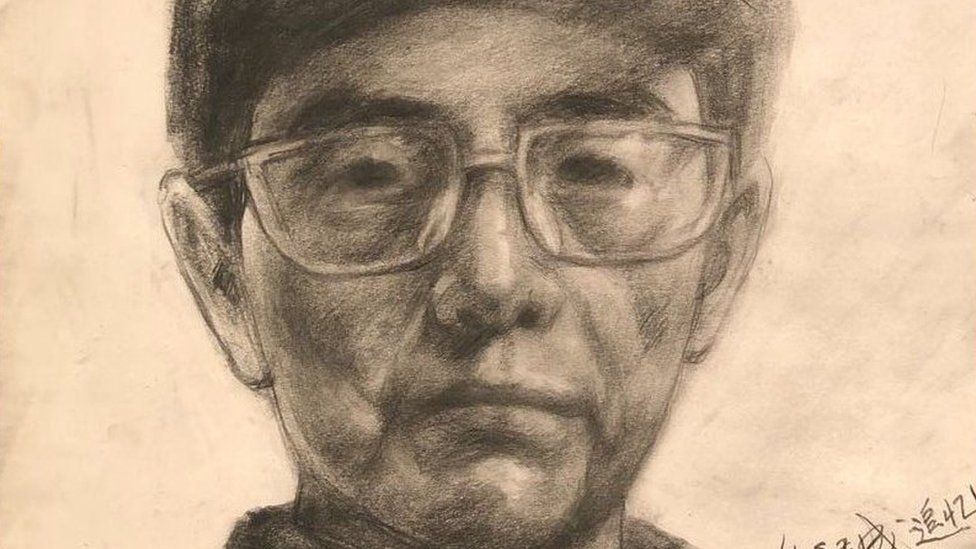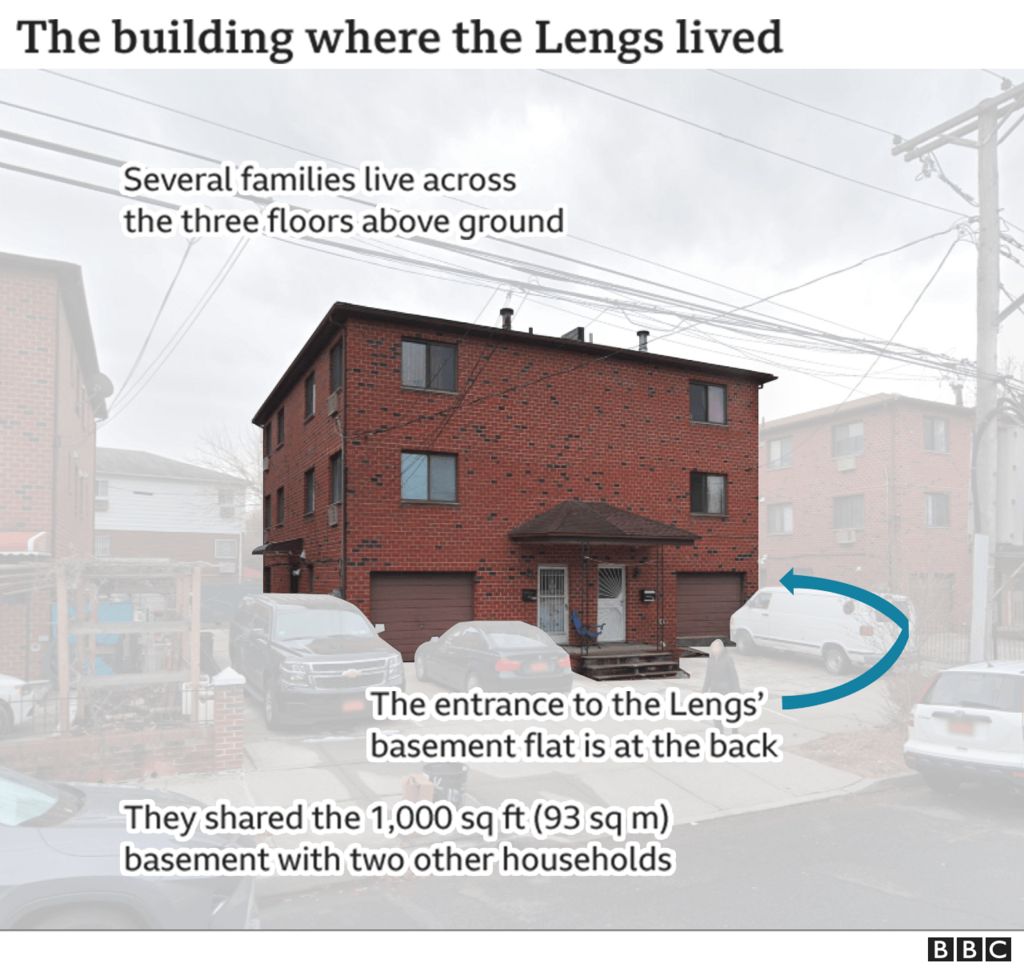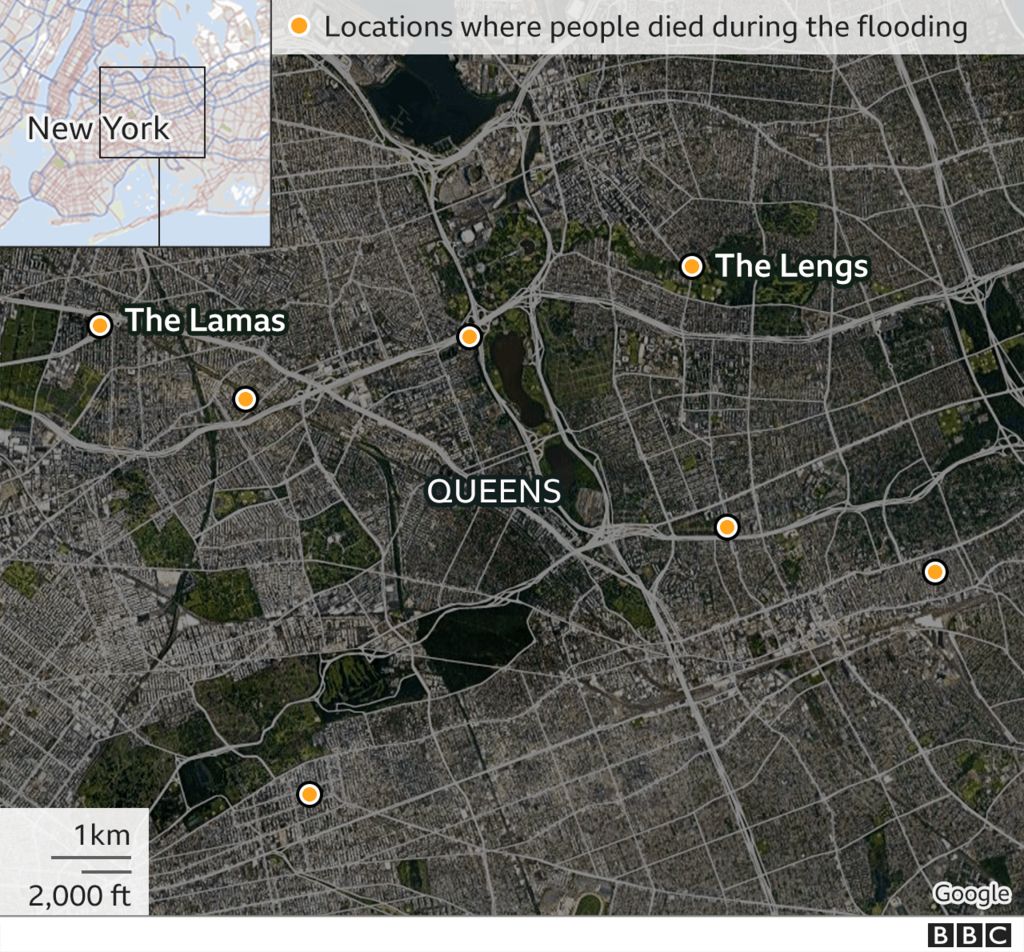
Like many who come to America, Leng Hongsheng was looking for freedom.
He arrived in the 1990s, having lived through the tumult of a world war, a cultural revolution and the emergence of a nation into modernity.
He was thought to have been an engineer back in China. In New York, he collected rubbish for a living, peddling around Chinatown in Queens looking for plastic bottles and electronics to recycle.
Still, he found joy, brought his family to the US and got a green card, endeavouring to make a better life.
That hope ended last month, when Mr Leng, 82, along with his wife and daughter, drowned in the turbid waters that flooded his tiny basement flat - one of 14 victims of Hurricane Ida in New York City.
The family was cremated on 3 October, a month after the devastating storm struck.
Most of the casualties in New York, including a two-year-old boy and a 86-year-old woman, were Asian and Hispanic immigrants living in illegal basement dwellings.
The tragedies have laid bare the ways in which extreme weather events ravage decaying infrastructure, devastate low-income communities and deepen social inequality, leading to what experts call a "climate apartheid".
Without a more equitable approach to intervention, the problem will only get worse.

Hurricane Ida, a powerful Category 4 storm, made landfall in Louisiana with wind speeds of 150mph (240 km/h). As it moved north, it left a trail of destruction with dozens killed and tens of thousands of homes seriously damaged. When it hit the Northeast on 1 September it would become the deadliest storm the region has faced since Hurricane Sandy in 2012.
The deluge started around sunset and continued until past midnight. New rainfall records had just been set days earlier by a tropical storm, only for them to be broken again when Ida arrived. Rainfall averages for the entire month of September were reached within a few hours, triggering one of the worst urban flood disasters in US history.

It was around 11pm when Wu Ming was woken up by the sound of water. He opened his eyes, only to realise that flood waters were gushing into his ground-floor flat, on the same block as the Leng family's home.
He looked out the window and saw cars floating in the streets. "I had never seen anything like that in my 10 years of living in New York," Mr Wu told the BBC in Mandarin. (Wu Ming isn't his real name, as he has asked not to be identified.)
In less than two minutes, the water rose from his knees to his chest. He tried to escape through his front door, but to his shock, it wouldn't move an inch - he could not prise it open against the powerful cascade of water. He fled through the back door and spent a sleepless night on the outside staircase.
"I thought 'just endure tonight, we'd all be okay tomorrow,'" Mr Wu, a builder in his 50s, told the BBC.
There were glimpses of hope. A resident swam through the flash flood and rescued a cat and a dog from a flooded apartment. Residents on higher floors provided shelters to others.
It crossed Mr Wu's mind at some point that he had not spotted the Leng family.
"I wanted to help them," Mr Wu said, "but the floods were so overwhelming. I couldn't even see the door to their basement."

Flooding is expected to be the environmental calamity that will affect the largest portion of the global population amid the climate crisis.
Today, some 1.5 billion people - about one in five people worldwide - face at least moderate flood risk, according to the World Bank. Nearly 90% of the world's flood-exposed people live in Southern hemisphere low-and middle- income countries, but rich countries are not immune, and nearly 160 million who live in the developed world are also vulnerable to floods.
In the coming decades, Europe, North America and other parts of the Northern hemisphere will see newly exposed areas prone to flooding - and in these places, too, the poorest will fare the worst.
In the US, about 41 million people are exposed to flood risk, concentrated in metropolitan areas where population density is high, and building on land newly prone to flooding is common.
Floodplains are often occupied by low-income and racial minority communities, as they are more likely to live in low-quality housing, where rents are cheaper, said Dr Shannon Van Zandt, Professor of Urban Planning at Texas A&M University.
Immigrants, whether documented or undocumented, are "often are even more vulnerable than our racial and ethnic minorities who are American citizens," she added, because they are more afraid to ask for help.

A narrow outdoor stairwell led down to the Lengs' underground home, a nondescript red-bricked house on a quiet street in Flushing, with multiple families sharing the three floors of a few rooms each. Theirs was one of at least three blocks of such abodes in the neighbourhood.
No sunlight reached the room in the back of the basements like the one where the Lengs had lived - even in daytime, when the BBC walked through a flat a few doors down, the place was obscured in darkness. A single skylight let in some sun near the front of the flat, but there is no other exit besides the door to the stairwell.
Days after the storm, dirt, toppled furniture and rubbish laid strewn about the Lengs' flooded flat. Intense musty odours permeated the air and lingered around the neighbourhood.
In major US cities, as in many urban centres, a housing crisis has forced low-income renters into flats like those occupied by the family and other Ida victims.
"New York just doesn't have adequate housing for everyone who lives here, including the immigrants who are often very vulnerable," says Dr Jacqueline Klopp, co-director of the Center for Sustainable Urban Development at Columbia University.
There are many who tend to rely on informal networks within their communities to find housing, often illegal conversions constructed without proper permits.
There are around 50,000 illegal basement dwellings in New York City, according to the city's estimate.
Despite the hazards, tenants and homeowners often avoid reporting any issues due to fear of eviction or fines.
Two other household, also Chinese immigrants, shared the 93 sq m (1,000 sq ft) basement with the Lengs - but they were out at the time of the flood, one household having gone back to China for a visit and the other, a single man, out for work as a delivery man.
According to neighbours, the Lengs were housebound, surviving on government assistance as Mr Leng had suffered several strokes in recent years while his daughter was autistic and needed in-home care.
Only weeks before the storm, Mr Wu had asked Mr Leng's wife Shen why they kept living in such cramped conditions. The family had applied for federal housing, she told him, but it had not yet been approved.
"They did not realise their American Dream," Mr Wu said, sighing.
Five of the six properties where New Yorkers lost their lives during the floods are unlicensed cellar-level homes, city officials said.

The lack of quality housing is an obvious reason why poorer people are more at risk during an extreme weather event, but there are also less overt factors. Low-income communities, for example, tend to have far fewer trees and green spaces.
During heatwaves, concrete surfaces become traps for hot temperatures and in floods, they prevent water from draining.
Most of the New York Ida flood fatalities were residents living in areas near large impervious surfaces, such as highways and car parks. Several people died in vehicles submerged on highways across the Northeast.
"We saw highways that were completely flooded out because it's where the water would run off. If the water can't get absorbed, the highways become rivers," Dr Klopp said.
Seven miles from the Lengs' home, the Lama family from Nepal lived in the basement of a brick house next to two major highways in Maspeth, Queens.
Ang Gelu Lama, 50, had come to the US from Nepal 14 years ago. He and his wife Mingma Yangji Sherpa had a two-year-old son Lopsang, who had red, chubby cheeks and liked playing with monkey toys. A family friend told the Washington Post that the family lived in the cramped basement space for the cheap rent.
The last phone call Mrs Sherpa made was to a neighbour upstairs, telling her that flood waters were seeping into her flat.

A makeshift memorial now stands in front of the Lamas' home, displaying a black-and-white family photo, Lopsang's stuffed monkey and two lollipops.
On a recent day, Nuku Sherpa, Mr Lama's aunt, broke down in tears as she chanted a Buddhist prayer for the Lamas. Ms Sherpa, who lives in New Jersey, had just cleaned up her own flooded flat when she learnt of their deaths.
"We are heartbroken," she said.

In all, Hurricane Ida tore through 1,500 miles of the continental US over the course of three days, spawning tornadoes in at least seven states, record rainfalls across the country and bringing about New York City's first-ever flash flood emergency.
Days after the storm, Mr Wu returned to salvage his belongings and to drain floodwaters from his mud-covered car, hoping that the engine could restart when dried. He couldn't bear to lose it, he said, after almost everything else had been taken by the water. "Even the trousers that I am wearing now are borrowed," he said.
It can take low-income and marginalised communities as much as twice as long to recover from a disaster, Dr Van Zandt said, as they are less likely to have the resources to rebuild or relocate.
The extremes in how the rich and the poor can respond to climate disasters is already being seen.
A 2019 UN report noted that when Hurricane Sandy left large swathes of New York City in the dark in 2012, the headquarters of the investment bank Goldman Sachs in Lower Manhattan was protected by a massive wall of sandbags. Private firefighters have been hired to save mansions from wildfires in California.
The report estimates that climate change could push more than 120 million people into poverty by 2030, undoing 50 years of progress on poverty reduction.
The effects will not only threaten basic human rights, such as life, food, housing and water, but also the rule of law and democracy.
The class divide has also entered the public consciousness in fiction. Parasite, an Oscar-winning South Korean film, depicts a poor family living in Seoul forced to flee their employer's luxurious mansion during a storm, only to discover that their subterranean home is heavily flooded and most of their belongings ruined.
This new "climate apartheid" has brought the world to the point of a "historic ultimatum," Dr Klopp said, and the crisis demands an approach that addresses not only environmental, but also social equality issues, locally and globally.
"We really have to be able to grapple with climate and equity. They are inseparable."

Since its days as a Dutch colonial outpost, openness has been a defining character for Flushing. Its 17th Century charter enshrined freedom of religious worship, welcoming Quaker refugees fleeing persecution.
A rail that connected the neighbourhood to the rest of New York City in the 19th century fostered its popularity and encouraged the arts. Eventually it became a hotbed for entertainment, a precursor to Hollywood.
In more recent decades, it has become an enclave for immigrants. Within its 800 acres are thriving communities from Taiwan, South Korea, China and India.
Though his life in the city was not easy, Mr Leng embraced New York. "He loved the artistic and political freedom here," his former immigration lawyer Norman Wong told the BBC.
Born in Northeast China in 1939, he had a poetic name: Hongsheng, which means an ascending wild goose.
He immigrated when he was in his 50s to pursue a life as a New Yorker, painting Chinese landscapes and once submitting a design for the World Trade Center memorial competition. He also became politically active in America, penning newspaper commentary critical of the Chinese Communist Party and joining the "China Democratic Party".
Citing fear of persecution in China, Mr Leng applied for political asylum in the US in the 2000s, and his case is still cited by local immigration lawyers.
The Lengs' deaths have been widely remarked upon in China, with many wondering on social media why the patriarch chose such a seemingly impoverished life for his family.
Asked one user: "He loved America, but did America love him back?"
In the starkest way, the country failed him - but perhaps in another way, he was loved. In the month after their deaths, the Chinese-American community pooled the money to cover their funeral costs and to send their ashes back to their homeland - an act, as a Chinese proverb goes, of returning fallen leaves to their roots.
"that" - Google News
October 05, 2021 at 06:58AM
https://ift.tt/2Yn1BYM
The flood that drowned American dreams - BBC News
"that" - Google News
https://ift.tt/3d8Dlvv

Tidak ada komentar:
Posting Komentar